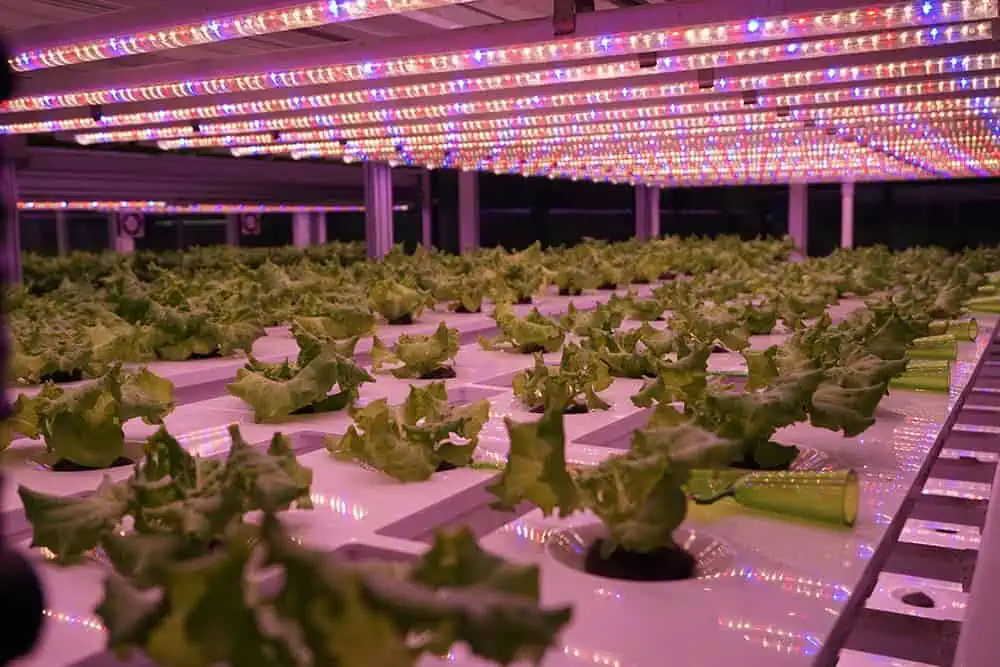If you're planning an indoor garden setup or gardening, LED grow lights are what you need right now! Plants need light for photosynthesis. But is all light effective for plant growth? The answer is a very, very big "no".
LED grow lights provide plants with the effect of simulating sunlight indoors. These lights emit a specific spectrum (especially red and blue) that affects plant growth. LED grow lights can be divided into different types according to their design, spectrum and configuration. In addition to LEDs, there are other forms of grow lights such as fluorescent, HID, etc. But LED is the best choice because it offers extensive customization to meet the needs of the plant, is durable, emits less heat and is energy efficient.
What are LED Grow Lights?
LED grow lights are designed to mimic the sunlight that affects the photosynthesis process of plants. They are used for indoor cultivation to provide suitable lighting for cultivation. Because these lights directly affect the growth of plants, they are called grow lights.
These lights are typically used in industrial grade grows. You can also use them for gardening, plant propagation, indoor gardening, food production and home use. However, in addition to LEDs, other options such as incandescent, high-intensity discharge (HID) and fluorescent are also in use. But Light Emitting Diode or LED technology is the most popular as it yields the highest Photosynthetically Active Radiation (PAR) of any light. It offers different color temperatures, spectra, intensities, etc., which help to provide ideal lighting for different types of plant growth. dditionally, the versatility and energy efficiency of LEDs make them more popular than technologies such as HID or metal halide (MH).
What is the working principle of LED plant growth lights?
To understand the working principle of LED plant lights, you first need to understand the working principle of photosynthesis in plants. Food is essential for the growth of any living thing. The same is true of plants, since they are also living objects. The LED lights mimic sunlight's natural role in photosynthesis, producing carbohydrates in the form of glucose to ensure plant growth. Let's take a deeper look at the working principle of LED plant growth lights and how it creates artificial sunlight effects——
1.The role of sunlight in photosynthesis
Sunlight is one of the important elements in the food production system or the process of photosynthesis in plants. Chloroplasts in plants absorb specific spectrums of sunlight to produce high-energy electrons. These electrons are then used to form more stable energy that combines carbon dioxide into carbohydrates. This carbohydrate is the food or energy source that helps plants grow. Thus, plants convert light energy into chemical energy, producing the energy/food necessary for their growth. LED grow lights also follow the same mechanism.
2.LED Grow Lights Mimic Sunlight
LEDs use semiconducting metals to mimic the lighting effects of sunlight. These semiconductors are of two types. One is positively charged (called a hole) and the other is negatively charged (called an electron). When the right voltage is passed through the holes and electrons, they collide. As a result of this collision, it releases energy via photons, a process called recombination. The resulting light is absorbed by the plant's chlorophyll, which converts light energy into carbohydrates.
However, different plants require different light spectra to activate their photosynthetic process. Each of these spectra has its own unique effect on plant growth. Most plants are exposed to red and blue light for normal growth. But other colors including greens, dark blues and far reds can also bring dramatic effect to plant growth. To meet these needs, LED grow lights offer customizable options to meet all categories of plant requirements.

Types of LED Grow Lights
Depending on specific considerations, LED grow lights can be of different types. Here I have categorized these lamps based on spectrum, different LED technologies and fixture designs -
spectrum based
Considering the light spectrum suitable for plant growth, LED grow lights can be divided into three main types. These are as follows -
1.LED Grow Lights: Blue Light Spectrum
The vegetative phase of plants requires the blue light spectrum to strictly maintain the growth cycle. Considering this factor, plant LED grow lights are specially designed for the vegetative growth stage of plants. They provide a spectrum of blue light in the 400-500 nm range. This wavelength of light promotes leaf and stem development, root growth and overall plant structure. It further stimulates chlorophyll production and allows more carbon dioxide to enter the leaves. Therefore, plant LEDs can emit light to support vigorous growth and photosynthesis of plants.
2.Blossom LED Grow Lights: Red Spectrum
After the vegetative phase of the plant, the flowering phase begins. This stage requires the red spectrum to stimulate the hormones needed for flowering and fruiting. Blossom LED Grow Lights are custom-made to meet the light requirements of your plants. The light they emit has a high proportion of red wavelengths (600-700 nm). This lighting stimulates the production of hormones that initiate the flowering process and promote the development of flowers and fruit. Thus, the flowing LED grow lights trigger the transition from vegetative to reproductive growth.
3.Full Spectrum LED Grow Lights
Full Spectrum LED Grow Lights replicate the natural sunlight spectrum, providing all wavelengths of light. They emit a balanced spectrum covering the entire visible light range (380 to 760 nm). These include red and blue light covering the growth and flowering stages of plants. In addition, other spectra such as orange, yellow, green, ultraviolet and far-red are also included. Therefore, full-spectrum LED grow lights can meet the lighting needs of all life stages of plants from seedlings to vegetative growth and flowering.
Based on LED light configuration and technology
Depending on the technology used, LED grow lights can be of different types. These are as follows -
1.COB LED Grow Light (Chip on Board)
If you're looking for full-spectrum grow lights, COB LEDs are an excellent choice. You can use them throughout the growth stages of your plants without worrying about spectral shifts. In COB LED grow lights, LEDs are closely arranged on one board. This arrangement allows them to provide even lighting throughout the indoor garden. It further reduces hot spots and shadows, ensuring all plants receive equal light.
2.Quantum Board LED Grow Light
The Quantum Board LED Grow Light has a large circuit board with many small LEDs on it. They are often low-profile to allow light to penetrate deeper into the canopy and reach the lower leaves and branches. Plus, they generate less heat than traditional high-intensity discharge (HID) lights or older LED designs. The lower heat output helps maintain a more favorable environment for plant growth, reducing the need for additional cooling equipment. Some Quantum Panel LED grow lights also offer adjustable light spectrum and intensity settings. Thus, you can tailor the light output to the requirements of your particular plant.
3.High Intensity LED Grow Lights
High intensity LED grow lights are ideal for plants requiring high photosynthetically active radiation (PAR). They can provide high light output to support vigorous plant growth and development. This is why they are very suitable for industrial production. Additionally, high-intensity LED grow lights come in a variety of shapes and configurations, including panels, strips, and modules. This versatility allows you to tailor your lighting setup to the size and layout of your growing area.
Design and layout based on LED lamps
Different types of LED light fixtures are used as LED grow lights. Hence, LED grow lights can come in different types; some of the main variants are as follows-
1.Panel LED Grow Light
Panel LED grow lights are the most common type of light for indoor gardening. Whether it is a small or large indoor garden, these lights are considered a standard option. They consist of a flat panel with multiple LEDs arranged in a grid pattern. The LEDs on these fixtures provide a balanced light spectrum. They have red, blue, and sometimes white lights. It may also include other spectrums, such as yellow, green, and orange, to provide full-spectrum lighting.
2.Vertical Farming LED Grow Lights
In vertical farming, plants are stacked in layers to maximize space. The vertical farming LED lights have a compact, slim design that can provide ample lighting for such a dense plant arrangement. They minimize shade and ensure that each plant receives sufficient light for optimal growth. Their small form factor allows for efficient use of space and easy integration into vertical farming setups. These lights often have flexible installation options. Therefore, you can adjust the beam angle according to the lighting requirements of your plants.
3.T5 LED Grow Light
The T5 LED Grow Light is a great alternative to traditional fluorescent lights. They are more energy efficient and do not produce harmful fumes like fluorescent lights. T5 LED grow lights are mainly used for indoor seed germination, cloning and early vegetative growth stages. They are very light and simple in design. This feature makes them ideal for small-scale settings, tight spaces or areas with height restrictions. In addition, T5 LED grow lights are easy to maintain and more cost-effective than other forms of lighting.
Strip LED grow lights are often used as supplemental lighting with larger LED panels or HID lights to provide additional light coverage. These grow lights are extremely flexible, allowing you to install them in any significant garden space. If you have a tight garden arrangement and limited space, LED strip lights are the first choice for you. These lights ensure that all your plants receive adequate lighting to ensure proper growth. Additionally, LED strip lights are highly customizable. You can contact LED Easy to customize LED light bars to meet your gardening requirements. We also provide OEM and ODM facilities!

Advantages of LED Grow Lights
LED grow lights bring a wide range of advantages for indoor gardening or gardening. These are as follows -
1.Economic electricity consumption
LED grow lights are very energy efficient. They use about 80% less energy than fluorescent grow lights. Therefore, using LED grow lights can save on your electricity bills and minimize overall gardening costs.
2.longer service life
The durability and sturdiness of LED grow lights make them the best choice for indoor gardening. Fluorescent or high-intensity discharge (HID) lamps have a lifespan of approximately 10,000 to 20,000 hours, while LED lamps can emit light for 50,000 to 100,000 hours. That is to say, if an LED keeps shining and is used for 12 hours a day, it can be used for about 11 to 22 years! Furthermore, they do not require frequent repairs and replacements. This makes your light maintenance easier.
3.Small space and convenient
LED grow lights come in a variety of designs and patterns for intensive gardening environments. Vertical Farming LED Grow Lights, T5 LED Grow Lights, and Panel LED Grow Lights are great options here. Their slim and compact design makes them suitable for installation in tight spaces. Additionally, strip LED grow lights are a great option for providing supplemental lighting. You can install them in any corner of your garden to ensure that the light reaches even the base of the plants.
4.Minimal Heat Generation: Fire Safety
The LED grow light has a high-efficiency heat sink to keep the light cool while it is running. This also keeps the indoor garden looking good without heating it up. Others glow like fluorescent lights and overheat quickly, creating a fire hazard. But with LED grow lights, you don't need to worry about these factors.
5.Dimming ability
Many LED grow lights have dimming capabilities. They allow you to adjust the light intensity according to the requirements of the plants. Therefore, you can grow a variety of plants under the same light setting. You don't need to change fixtures for different plants.
6.Better crop quality and yield
Different plants have different spectral requirements. Some may require more blue light, while others require red. It promotes photosynthesis, chlorophyll production and overall plant health. This ultimately leads to better crop quality, higher yields and faster growth.
7.More environmental safety
Compared to other lighting options, LED grow lights are more environmentally friendly. They do not contain harmful substances such as mercury commonly found in fluorescent lamps. Additionally, these lights are free of harmful ultraviolet (UV) and infrared (IR) emissions. Thus, LEDs ensure a safer environment for plants and growers.
Disadvantages of LED Grow Lights
In addition to the many advantages of LED grow lights, it also has some disadvantages. These are as follows -

1.higher upfront costs
The biggest disadvantage of LED grow lights is their high upfront cost. LED lights are quite expensive compared to traditional grow lights like fluorescents and HIDs. In addition, there are installation costs. LEDs offset the initial cost, though, considering maintenance costs and electricity bills.
2.limited light penetration
Plants with thick canopies require full lighting to ensure adequate distribution of light to the lower leaves and branches. However, LED grow lights sometimes fail to meet these requirements due to the focused and directional nature of their light. While this is good for light efficiency, the light cannot reach the densely foliage canopy. However, you can solve this problem with supplemental lighting. For example, you can install LED strip grow lights with LED panels or vertical farming LED grow lights. This will ensure that light reaches the entire garden.
3.Risk of low quality products
LEDs are the most popular and most expensive category of grow lights. In order to take advantage of this, many dishonest merchants put low-quality lamps on the market for extra profits. Therefore, these lamps cannot provide the desired wavelength or spectrum of light. Additionally, they are not durable enough and need to be replaced frequently. To avoid this, you should research the brand's authenticity before purchasing any LED grow lights.
Author 2025-06-12
Hishine Group Limited Will Meet Customers In Mexico City.Hishine is thrilled to announce its participation in Expo Eléctrica International 2025, Latin America’s premier trade fair for power and lighti...
Author 2025-05-12
Our recent business trip to Saudi Arabia proved to be a pivotal step in strengthening partnerships and exploring opportunities in the Kingdom’s rapidly growing energy and lighting markets. Below are t...